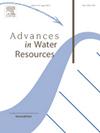Multi-temporal drought rarity curves—A yearly classification of meteorological drought severity in France
IF 4
2区 环境科学与生态学
Q1 WATER RESOURCES
引用次数: 0
Abstract
Droughts are recurrent phenomena that present a large variety of space and time patterns making rather difficult the assessment of their rarity and the comparison between events.
Our study focuses on the “memory effect” of meteorological drought over France using the daily raingauge network maintained by Météo-France over 1950–2022. The proposed easy tool of rarity curves analyses how drought events build and persist across time. The approach is purely statistic, assuming that drought consequences depend on the probability of non exceedance (“rarity”) of antecedent rainfall accumulations. In order to cover a large spectrum of “memory effects”, we consider a continuum of accumulation periods ranging from a few weeks to several years. The rarity curve of a given year displays the most severe rarity values encountered during the year as a function of the various accumulation periods (256 values ranging from 4 to 260 weeks in our case).
Over the study period of 1950–2022 we show how the shape of rarity curves discriminate short- and long-term historical droughts. A k-means algorithm proves to be useful to classify the different years into typical drought situations from continuous drying to continuous wetting over the antecedent five years. Looking at the chronology of the found clusters also allows studying how droughts build and persist across time.

多时干旱稀有性曲线--法国气象干旱严重程度的年度分类
干旱是一种反复出现的现象,在空间和时间上表现出多种多样的模式,这给评估干旱的罕见程度和事件之间的比较造成了相当大的困难。我们的研究重点是利用法国气象局在 1950-2022 年期间维护的日雨量计网络,研究法国气象干旱的 "记忆效应"。我们提出的稀有性曲线这一简便工具分析了干旱事件是如何形成并持续一段时间的。该方法纯粹是统计性的,假定干旱后果取决于前降雨累积量不超标的概率("稀有性")。为了涵盖各种 "记忆效应",我们考虑了从几周到几年不等的累积期。在 1950-2022 年的研究期间,我们展示了稀有度曲线的形状如何区分短期和长期历史干旱。事实证明,k-means 算法有助于将不同年份划分为典型的干旱情况,从连续干旱到前五年连续湿润。通过观察所发现组群的时间顺序,还可以研究干旱是如何跨时间形成和持续的。
本文章由计算机程序翻译,如有差异,请以英文原文为准。
求助全文
约1分钟内获得全文
求助全文
来源期刊

Advances in Water Resources
环境科学-水资源
CiteScore
9.40
自引率
6.40%
发文量
171
审稿时长
36 days
期刊介绍:
Advances in Water Resources provides a forum for the presentation of fundamental scientific advances in the understanding of water resources systems. The scope of Advances in Water Resources includes any combination of theoretical, computational, and experimental approaches used to advance fundamental understanding of surface or subsurface water resources systems or the interaction of these systems with the atmosphere, geosphere, biosphere, and human societies. Manuscripts involving case studies that do not attempt to reach broader conclusions, research on engineering design, applied hydraulics, or water quality and treatment, as well as applications of existing knowledge that do not advance fundamental understanding of hydrological processes, are not appropriate for Advances in Water Resources.
Examples of appropriate topical areas that will be considered include the following:
• Surface and subsurface hydrology
• Hydrometeorology
• Environmental fluid dynamics
• Ecohydrology and ecohydrodynamics
• Multiphase transport phenomena in porous media
• Fluid flow and species transport and reaction processes
 求助内容:
求助内容: 应助结果提醒方式:
应助结果提醒方式:


